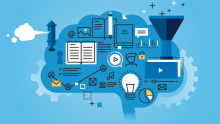
Artificial intelligence (AI) at the edge: 3 key facts
Blog: The Enterprise Project - Digital Transformation
Artificial intelligence (AI) at the edge: 3 key facts
Brian McCarson
September 21, 2021 – 3:01am
Artificial Intelligence (AI) is moving from the realm of science fiction to widespread enterprise scalability. Even ten years ago, AI workloads were almost exclusively utilized by a small number of very profitable companies that had the resources to experiment and hire an extensive team of data scientists. Today, AI is used in a number of everyday tools, from language recognition to health care prediction and nearly every industry in between.
AI is also now deployed at the edge, not just inside massive data processing facilities. That trend will continue in the coming years. Here are three things that executives in any field should know to capitalize on the change.
[ Get our primer on 10 key artificial intelligence terms for IT and business leaders: Cheat sheet: AI glossary. ]
1. Open source is your friend
Open source is fueling the rise of AI as developers learn from the larger community to make software elements more accessible for a number of use cases. The open source community operates as a school of fish, pivoting quickly en masse in response to the environment. For example, TensorFlow became a hit within a month before the majority of developers converted to the library for deployment solutions. That fast a timeline was unheard of before.
Open source is helping rapidly evolve industries by creating new abilities to scale, in part because companies no longer need a large team of data scientists for every sector. Not too long ago, there was a concern that the scarcity of data scientists would stall the growth of AI. But we now see software developers with all kinds of different backgrounds turning to open source AI tools for a variety of business innovations.
2. Video information is huge
One thing I don’t see enough of today is the realization of the vast amount of information you can get from video, especially at higher resolutions. From industrial settings to retail optimization, video is going to be an enormous factor in how businesses operate and stay competitive. However, because that video information is so data-heavy, it’s cost-prohibitive to send higher resolution images to a centralized cloud for inferencing tasks. It’s far better to have inference done at the point of deployment and then send those results to a centralized cloud for additional model training.
[ Want best practices for AI workloads? Get the eBook: Top considerations for building a production-ready AI/ML environment. ]
So it makes business sense to deploy AI at the edge, but that also expands the need for more computing at the edge. The edge is cheaper when looking at total cost of ownership (TCO), but it also fuels a sort of symbiotic relationship – the more success found using AI deployments, the greater need for edge computing, and better processing at the edge creates more value from those AI deployments. This compounding relationship is creating a whole new set of emerging business opportunities, from content delivery to services yet to be unleashed.
3. More changes are coming
One of my favorite quotes is “Chance favors the prepared mind,” from the famous French scientist Louis Pasteur. It sounds obvious, but when you’re picking your systems, whether it’s for retail stores or factories, assume you’ll need to upgrade sooner than you’d expect. Innovation in AI is happening at such a rapid pace that your organization is going to have to pivot to new software and hardware as trends catch on in the developer community. My advice is to find microservices frameworks that can scale so that as opportunities present themselves, you’ll be ready to take advantage of the benefits.
AI is touching every field. In health care, medical imaging processing allows radiologists to achieve greater accuracy in diagnoses and therefore better patient outcomes. With mechanisms for lane departure alerts, automatic braking, cameras, and more, AI is making cars safer. In an industrial setting, factories are getting faster and more accurate defect detection to alleviate the repetitive burden on humans. In retail, AI is enabling better sales information about demographics, store layout, and even tailored engagement to determine, for example, if a dad is shopping with his kids for back-to-school time or if a couple is out running errands.
There isn’t a field that some sort of AI won’t have a role in at the edge. By embracing the value open source will continue to have within the developer community, understanding the role of video information across fields, and planning for ongoing changes and sudden pivots, your organization can better prepare for how AI at the edge will change business in the coming years.
[ How does AI connect to hybrid cloud strategy? Get the free eBooks, Hybrid Cloud Strategy for Dummies and Multi-Cloud Portability for Dummies. ]

What to read next
Leave a Comment
You must be logged in to post a comment.








